One Health in Coastal and Marine Contexts: A Critical Bibliometric Analysis Across Environmental, Animal, and Human Health Dimensions
Abstract
1. Introduction
- How has the scientific production on the application of the One Health framework in coastal and marine ecosystems evolved during the period 2003–2025?
- What are the most frequent thematic domains and research gaps, as revealed by keyword co-occurrence networks and thematic maps?
- Which sources, authors, and journals contribute most to shaping the field, according to productivity distributions and citation impact?
- What is the geographical distribution of research, and how are authors, keywords, and journals interconnected in shaping thematic contributions?
- How is the dual research orientation (biomedical vs. environmental) reflected in the Multiple Correspondence Analysis (MCA)?
- What is the scope and intensity of international collaborations, and what imbalances appear in the participation of low- and middle-income regions?
2. Materials and Methods
2.1. Study Design
2.2. Search Strategy
2.3. Data Collection and Processing
2.4. Data Analysis
3. Results
3.1. Analytical Definitions and Bibliometric Laws
3.2. Bibliometric Patterns of One Health Research in Coastal and Marine Contexts
4. Discussion
5. Conclusions
Author Contributions
Funding
Data Availability Statement
Acknowledgments
Conflicts of Interest
References
- Destoumieux-Garzón, D.; Mavingui, P.; Boetsch, G.; Boissier, J.; Darriet, F.; Duboz, P.; Fritsch, C.; Giraudoux, P.; Le Roux, F.; Morand, S.; et al. The One Health Concept: 10 Years Old and a Long Road Ahead. Front. Vet. Sci. 2018, 5, 14. [Google Scholar] [CrossRef]
- WHO. Climate Change and Health; World Health Organization: Geneva, Switzerland, 2023; Available online: https://www.who.int/news-room/fact-sheets/detail/climate-change-and-health (accessed on 15 July 2025).
- Mackenzie, J.S.; Jeggo, M. The One Health Approach—Why Is It So Important? Trop. Med. Infect. Dis. 2019, 4, 88. [Google Scholar] [CrossRef] [PubMed]
- Lerner, H.; Berg, C. The Concept of Health in One Health and Some Practical Implications for Research and Education: What Is One Health? Infect. Ecol. Epidemiol. 2017, 7, 1303264. [Google Scholar] [CrossRef]
- Whitmee, S.; Haines, A.; Beyrer, C.; Boltz, F.; Capon, A.G.; De Souza Dias, B.F.; Ezeh, A.; Frumkin, H.; Gong, P.; Head, P.; et al. Safeguarding Human Health in the Anthropocene Epoch: Report of the Rockefeller Foundation–Lancet Commission on Planetary Health. Lancet 2015, 386, 1973–2028. [Google Scholar] [CrossRef]
- Myers, S.S. Planetary Health: Protecting Human Health on a Rapidly Changing Planet. Lancet 2017, 390, 2860–2868. [Google Scholar] [CrossRef]
- Zinsstag, J.; Schelling, E.; Waltner-Toews, D.; Tanner, M. From “One Medicine” to “One Health” and Systemic Approaches to Health and Well-Being. Prev. Vet. Med. 2011, 101, 148–156. [Google Scholar] [CrossRef]
- Bonilla-Aldana, D.K.; Dhama, K.; Rodriguez-Morales, A.J. Revisiting the One Health Approach in the Context of COVID-19: A Look into the Ecology of This Emerging Disease. Adv. Anim. Vet. Sci. 2020, 8, 234–237. [Google Scholar] [CrossRef]
- Morand, S.; Lajaunie, C.; Agyeman, Y.B. Biodiversity and Health: Linking Life, Ecosystems and Societies; CRC Press: Boca Raton, FL, USA, 2022. Available online: https://catalog.nlm.nih.gov/permalink/01NLM_INST/1o1phhn/alma9917329563406676 (accessed on 1 August 2025).
- Cosby, A.G.; Small, C.; Lwin, K.T.; Remais, J.; Saldarriaga, I. Accelerating Growth of Human Coastal Populations at the Land–Sea Interface. Sci. Rep. 2024, 14, 73287. [Google Scholar] [CrossRef]
- IPCC. Climate Change 2022: Impacts, Adaptation and Vulnerability. Contribution of Working Group II to the Sixth Assessment Report of the Intergovernmental Panel on Climate Change; IPCC: Geneva, Switzerland, 2022; Available online: https://www.ipcc.ch/report/ar6/wg2/ (accessed on 1 August 2025).
- Ebi, K.L.; Vanos, J.; Baldwin, J.W.; Bell, J.E.; Hondula, D.M.; Errett, N.A.; Hayes, K.; Reid, C.E.; Saha, S.; Spector, J.; et al. Extreme Weather and Climate Change: Population Health and Health System Implications. Annu. Rev. Public Health 2021, 42, 293–315. [Google Scholar] [CrossRef]
- Barbier, E.B.; Hacker, S.D.; Kennedy, C.; Koch, E.W.; Stier, A.C.; Silliman, B.R. The Value of Estuarine and Coastal Ecosystem Services. Ecol. Monogr. 2011, 81, 169–193. [Google Scholar] [CrossRef]
- Gamfeldt, L.; Lefcheck, J.S.; Byrnes, J.E.; Cardinale, B.J.; Duffy, J.E.; Griffin, J.N. Marine Biodiversity and Ecosystem Functioning: What’s Known and What’s Next? Oikos 2015, 124, 252–265. [Google Scholar] [CrossRef]
- Smale, D.A.; Wernberg, T.; Oliver, E.C.J.; Thomsen, M.; Harvey, B.P.; Straub, S.C.; Burrows, M.T.; Alexander, L.V.; Benthuysen, J.A.; Donat, M.G.; et al. Marine Heatwaves Threaten Global Biodiversity and the Provision of Ecosystem Services. Nat. Clim. Change 2019, 9, 306–312. [Google Scholar] [CrossRef]
- Wells, M.L.; Trainer, V.L.; Smayda, T.J.; Karlson, B.S.; Trick, C.G.; Kudela, R.M.; Wulff, A.; Asnaghi, V.; Berdalet, E.; Cochlan, W.; et al. Future HAB Science: Directions and Challenges in a Changing Climate. Harmful Algae 2020, 91, 101632. [Google Scholar] [CrossRef]
- Vezzulli, L.; Grande, C.; Reid, P.C.; Hélaouët, P.; Edwards, M.; Höfle, M.G.; Brettar, I.; Colwell, R.R.; Pruzzo, C. Climate Influence on Vibrio and Associated Human Diseases during the Past Half-Century in the Coastal North Atlantic. Proc. Natl. Acad. Sci. USA 2016, 113, E5062–E5071. [Google Scholar] [CrossRef]
- Baker-Austin, C.; Trinanes, J.A.; Taylor, N.G.; Hartnell, R.; Siitonen, A.; Martinez-Urtaza, J. Emerging Vibrio Risk at High Latitudes in Response to Ocean Warming. Nat. Clim. Change 2013, 3, 73–77. [Google Scholar] [CrossRef]
- Rico, A.; Phu, T.M.; Satapornvanit, K.; Min, J.; Shahabuddin, A.M.; Henriksson, P.J.; Murray, F.J.; Little, D.C.; Dalsgaard, A.; Brink, P.J.V.D. Use of Veterinary Medicines, Feed Additives and Probiotics in Four Major Internationally Traded Aquaculture Species Farmed in Asia. Aquaculture 2012, 412, 231–243. [Google Scholar] [CrossRef]
- Henriksson, P.J.G.; Rico, A.; Troell, M.; Klinger, D.H.; Buschmann, A.H.; Saksida, S.; Chadag, M.V.; Zhang, W. Unpacking Factors Influencing Antimicrobial Use in Global Aquaculture and Their Implications for Management: A Review from a Systems Perspective. Sustain. Sci. 2018, 13, 1105–1120. [Google Scholar] [CrossRef]
- UNEP. From Source to Sea: Protecting Coastal and Marine Ecosystems Through Integrated Watershed Management; United Nations Environment Programme: Nairobi, Kenya, 2023; Available online: https://resolutions.unep.org/uploads/unepgpaigr.4inf5.pdf (accessed on 18 September 2025).
- Bowen, R.E.; Riley, C. Socio-Economic Indicators and Integrated Coastal Management. Ocean Coast. Manag. 2003, 46, 299–312. [Google Scholar] [CrossRef]
- Spatharis, S.; Tsirtsis, G.; Danielidis, D.B.; Do Chi, T.; Mouillot, D. Effects of Pulsed Nutrient Inputs on Phytoplankton Assemblage Structure and Blooms in an Enclosed Coastal Area. Estuar. Coast. Shelf Sci. 2007, 73, 807–815. [Google Scholar] [CrossRef]
- Ferreira, J.G.; Andersen, J.H.; Borja, Á.; Bricker, S.B.; Camp, J.; Cardoso da Silva, M.; Garcés, E.; Heiskanen, A.-S.; Humborg, C.; Ignatiades, L.; et al. Overview of Eutrophication Indicators to Assess Environmental Status within the European Marine Strategy Framework Directive. Estuar. Coast. Shelf Sci. 2011, 93, 117–131. [Google Scholar] [CrossRef]
- Paerl, H.W.; Otten, T.G.; Kudela, R. Mitigating the Expansion of Harmful Algal Blooms across the Freshwater-to-Marine Continuum. Environ. Sci. Technol. 2018, 52, 5519–5529. [Google Scholar] [CrossRef]
- Hilborn, E.D.; Beasley, V.R. One Health and Cyanobacteria in Freshwater Systems: Animal Illnesses and Deaths Are Sentinel Events for Human Health Risks. Toxins 2015, 7, 1374–1395. [Google Scholar] [CrossRef] [PubMed]
- European Commission. Directive 2008/56/EC of the European Parliament and of the Council Establishing a Framework for Community Action in the Field of Marine Environmental Policy (Marine Strategy Framework Directive). Off. J. Eur. Union. 2008. Available online: https://eur-lex.europa.eu/eli/dir/2008/56/oj (accessed on 1 August 2025).
- European Commission. Common Implementation Strategy for the Water Framework Directive and the Floods Directive—Guidelines on Ecological Status; European Commission: Brussels, Belgium, 2017; Available online: https://ec.europa.eu/environment/water/water-framework/index_en.html (accessed on 1 August 2025).
- Sun, N.; Liu, R.; Wang, Y.; Liu, Z.; Zhang, H.; Zhao, X.; Zhu, Y.; Wei, H.; Zhang, Y.; Ji, R.; et al. Combined Toxicity of Micro/Nanoplastics Loaded with Contaminants from the Environment and Entering Organisms through a Systematic Review of 162 Articles. Sci. Total Environ. 2023, 873, 162123. [Google Scholar] [CrossRef]
- Hao, B.; Meng, X.; Zhang, C.; Li, J.; Tian, H.; Wang, W. Individual and Combined Toxicity of Microplastics and Diuron to Aquatic Organisms: Effects on Freshwater and Marine Diatoms. Sci. Total Environ. 2022, 838, 156463. [Google Scholar] [CrossRef]
- Devi, A.; De Silva, Y.S.K.; Tyagi, L.; Aaryashree. The Individual and Combined Effects of Microplastics and Heavy Metals on Marine Organisms. Microplastics 2025, 4, 38. [Google Scholar] [CrossRef]
- Humboldt-Dachroeden, S.; Rubin, O.; Frid-Nielsen, S.S. The State of One Health Research across Disciplines and Sectors—A Bibliometric Analysis. One Health 2020, 10, 100146. [Google Scholar] [CrossRef]
- Miao, L.; Li, H.; Ding, W.; Lu, S.; Pan, S.; Guo, X.; Zhou, X.; Wang, D. Research Priorities on One Health: A Bibliometric Analysis. Front. Public Health 2022, 10, 889854. [Google Scholar] [CrossRef]
- Raphael, R.; As, D.; Karnaver, P.; Devy, R.; M, D.; Jose, J. Mapping Research Trends in One Health: A Comprehensive Review. Cureus 2024, 16, e70047. [Google Scholar] [CrossRef]
- Fang, Z.; Tu, S.; Huang, J. A Bibliometric Analysis of One Health Approach in Research on Antimicrobial Resistance. Sci. One Health 2024, 3, 100077. [Google Scholar] [CrossRef]
- Dos, S.; Ribeiro, C.; van de Burgwal, L.H.M.; Regeer, B.J. Overcoming Challenges for Designing and Implementing the One Health Approach: A Systematic Review of the Literature. One Health 2019, 7, 100085. [Google Scholar] [CrossRef]
- Borja, Á.; Elliott, M.; Carstensen, J.; Heiskanen, A.-S.; van de Bund, W. Marine Management—Towards an Integrated Implementation of the European Marine Strategy Framework and the Water Framework Directives. Mar. Pollut. Bull. 2020, 160, 111641. [Google Scholar] [CrossRef]
- FAO; UNEP; WHO; WOAH. One Health Joint Plan of Action (2022–2026): Working Together for the Health of Humans, Animals, Plants and the Environment. 2022. Available online: https://www.fao.org/documents/card/en/c/cc2289en (accessed on 1 August 2025).
- Rocklöv, J.; Dubrow, R. Climate Change: An Enduring Challenge for Vector-Borne Disease Prevention and Control. Nat. Immunol. 2020, 21, 479–483. [Google Scholar] [CrossRef] [PubMed]
- Robinson, T.P.; Bu, D.P.; Carrique-Mas, J.; Fèvre, E.M.; Gilbert, M.; Grace, D.; Hay, S.I.; Jiwakanon, J.; Kakkar, M.; Kariuki, S.; et al. Antibiotic Resistance Is the Quintessential One Health Issue. Trans. R. Soc. Trop. Med. Hyg. 2016, 110, 377–380. [Google Scholar] [CrossRef] [PubMed]
- Zhao, C.; Wang, Y.; Mulchandani, R.; Van Boeckel, T.P. Global surveillance of antimicrobial resistance in food animals using priority drugs maps. Nat. Commun. 2024, 15, 763. [Google Scholar] [CrossRef]
- Song, X.; Zhuang, W.; Cui, H.; Liu, M.; Gao, T.; Li, A.; Gao, Z. Interactions of Microplastics with Organic, Inorganic and Bio-Pollutants and the Ecotoxicological Effects on Terrestrial and Aquatic Organisms. Sci. Total Environ. 2022, 838, 156068. [Google Scholar] [CrossRef]
- Karesh, W. Championing “One Health”. Bull. World Health Organ. 2020, 98, 652–653. [Google Scholar] [CrossRef]
- Aria, M.; Cuccurullo, C. bibliometrix: An R-Tool for Comprehensive Science Mapping Analysis. J. Informetr. 2017, 11, 959–975. [Google Scholar] [CrossRef]
- Esposito, E.; Oliviero, M.; Iaccarino, D.; Paduano, G.; Serra, F.; Levante, M.; Amoroso, M.G.; Auriemma, C.; Gallo, A.; Lucibelli, M.G.; et al. Post Mortem Findings of Cetaceans Stranded Along the Campania Coast from 2016 to 2022. Animals 2025, 15, 1812. [Google Scholar] [CrossRef]
- Watts, J.E.M.; Schreier, H.J.; Lanska, L.; Hale, M.S. The Rising Tide of Antimicrobial Resistance in Aquaculture: Sources, Sinks and Solutions. Mar. Drugs 2017, 15, 158. [Google Scholar] [CrossRef]
- Miranda, C.D.; Godoy, F.A.; Lee, M.R. Current Status of the Use of Antibiotics and the Antimicrobial Resistance in the Chilean Salmon Farms. Front. Microbiol. 2018, 9, 1284. [Google Scholar] [CrossRef] [PubMed]
- Anderson, D.M.; Glibert, P.M.; Burkholder, J.M. Harmful Algal Blooms and Eutrophication: Nutrient Sources, Composition, and Consequences. Estuaries 2002, 25, 704–726. [Google Scholar] [CrossRef]
- OCCG. Synergy between Ocean Colour and Biogeochemical/Ecological Models; IOCCG Report Series, No. 19; International Ocean Colour Coordinating Group: Dartmouth, Canada, 2021; Available online: https://ioccg.org/wp-content/uploads/2019/03/ioccg_modelling_report_draft_20190321-rr.pdf (accessed on 1 August 2025).
- Adenaya, A.; Spriahailo, D.; Berger, M.; Noster, J.; Milke, F.; Schulz, C.; Reinthaler, T.; Poehlein, A.; Wurl, O.; Ribas-Ribas, M.; et al. Occurrence of Antibiotic-Resistant Bacteria in the Sea Surface Microlayer of Coastal Waters in the Southern North Sea. Ecotoxicol. Environ. Saf. 2024, 287, 117259. [Google Scholar] [CrossRef]
- Lai, S.; Zhou, H.; Xiong, W.; Gilbert, M.; Huang, Z.; Yu, J.; Yin, W.; Wang, L.; Chen, Q.; Li, Y.; et al. Changing Epidemiology of Human Brucellosis, China, 1955–2014. Emerg. Infect. Dis. 2017, 23, 184–194. [Google Scholar] [CrossRef]
- Khraishah, H.; Alahmad, B.; Ostergard, R.L., Jr.; AlAshqar, A.; Albaghdadi, M.; Vellanki, N.; Chowdhury, M.M.; Al-Kindi, S.G.; Zanobetti, A.; Gasparrini, A.; et al. Climate Change and Cardiovascular Disease: Implications for Global Health. Nat. Rev. Cardiol. 2022, 19, 798–812. [Google Scholar] [CrossRef]
- Troell, M.; Costa-Pierce, B.; Stead, S.; Cottrell, R.S.; Brugere, C.; Farmery, A.K.; Little, D.C.; Strand, Å.; Pullin, R.; Soto, D.; et al. Perspectives on Aquaculture’s Contribution to the Sustainable Development Goals for Improved Human and Planetary Health. J. World Aquac. Soc. 2023, 54, 251–342. [Google Scholar] [CrossRef]
- Caudell, M.A.; Quinlan, M.B.; Subbiah, M.; Call, D.R.; Roulette, C.J.; Roulette, J.W.; Roth, A.; Matthews, L.; Quinlan, R.J. Antimicrobial Use and Veterinary Care among Agro-Pastoralists in Northern Tanzania. PLoS ONE 2017, 12, e0170328. [Google Scholar] [CrossRef]
- Li, W.; Xiao, L. Ecological and Public Health Significance of Enterocytozoon bieneusi. One Health 2020, 12, 100209. [Google Scholar] [CrossRef] [PubMed]
- Tazerji, S.S.; Nardini, R.; Safdar, M.; Shehata, A.A.; Duarte, P.M. An Overview of Anthropogenic Actions as Drivers for Emerging and Re-Emerging Zoonotic Diseases. Pathogens 2022, 11, 1376. [Google Scholar] [CrossRef]
- Nieder, R.; Benbi, D.K. Reactive Nitrogen Compounds and Their Influence on Human Health: An Overview. Rev. Environ. Health 2021, 37, 229–246. [Google Scholar] [CrossRef] [PubMed]
- Lukić Bilela, L.; Matijošytė, I.; Krutkevičius, J.; Alexandrino, D.A.M.; Safarik, I.; Burlakovs, J.; Gaudêncio, S.P.; Carvalho, M.F. Impact of Per- and Polyfluorinated Alkyl Substances (PFAS) on the Marine Environment: Raising Awareness, Challenges, Legislation, and Mitigation Approaches under the One Health Concept. Mar. Pollut. Bull. 2023, 194, 115309. [Google Scholar] [CrossRef]
- Norman, S.A.; Palic, D.; Savage, A.C.N.P.; Plön, S.; Shields, S.; Venegas, C. Editorial: Aquatic One Health—The Intersection of Marine Wildlife Health, Public Health, and Our Oceans. Front. Mar. Sci. 2023, 10, 1227121. [Google Scholar] [CrossRef]
- Our Shared Seas. Threats: Pollution. Our Shared Seas. 2024. Available online: https://oursharedseas.com/threats/threats-pollution/ (accessed on 1 August 2025).
- Halpern, B.; Longo, C.; Hardy, D.; McLeod, K.L.; Samhouri, J.F.; Katona, S.K.; Kleisner, K.; Lester, S.E.; O’Leary, J.; Ranelletti, M.; et al. An Index to Assess the Health and Benefits of the Global Ocean. Nature 2012, 488, 615–620. [Google Scholar] [CrossRef]
- Rabinowitz, P.M.; Pappaioanou, M.; Bardosh, K.L.; Conti, L. A Planetary Vision for One Health. BMJ Glob. Health 2018, 3, e001137. [Google Scholar] [CrossRef]
- Holmes, A.H.; Moore, L.S.P.; Sundsfjord, A.; Steinbakk, M.; Regmi, S.; Karkey, A.; Guerin, P.J.; Piddock, L.J.V. Understanding the Mechanisms and Drivers of Antimicrobial Resistance. Lancet 2016, 387, 176–187. [Google Scholar] [CrossRef] [PubMed]
- Read, A.F.; Woods, R.J. Antibiotic Resistance Management. Evol. Med. Public Health 2014, 2014, 147–157. [Google Scholar] [CrossRef] [PubMed]
- Malham, S.K.; Taft, H.; Farkas, K.; Ladd, C.J.T.; Seymour, M.; Robins, P.E.; Jones, D.L.; McDonald, J.E.; Le Vay, L.; Jones, L. Multi-Scale Influences on Escherichia coli Concentrations in Shellfish: From Catchment to Estuary. Environ. Pollut. 2025, 366, 125476. [Google Scholar] [CrossRef] [PubMed]
- GBD 2019 Antimicrobial Resistance Collaborators. Global Mortality Associated with 33 Bacterial Pathogens in 2019: A Systematic Analysis for the Global Burden of Disease Study 2019. Lancet 2022, 400, 2221–2248. [Google Scholar] [CrossRef]
- Burge, C.A.; Mark Eakin, C.; Friedman, C.S.; Froelich, B.; Hershberger, P.K.; Hofmann, E.E.; Petes, L.E.; Prager, K.C.; Weil, E.; Willis, B.L.; et al. Climate Change Influences on Marine Infectious Diseases: Implications for Management and Society. Annu. Rev. Mar. Sci. 2014, 6, 249–277. [Google Scholar] [CrossRef]
- Harvell, C.D.; Kim, K.; Burkholder, J.M.; Colwell, R.R.; Epstein, P.R.; Grimes, D.J.; Hofmann, E.E.; Lipp, E.K.; Osterhaus, A.D.M.E.; Overstreet, R.M.; et al. Emerging Marine Diseases—Climate Links and Anthropogenic Factors. Science 1999, 285, 1505–1510. [Google Scholar] [CrossRef]
- Paillard, C.; Jean, F.; Ford, S.E.; Powell, E.N.; Klinck, J.M.; Hofmann, E.E.; Flye-Sainte-Marie, J. A Theoretical Individual-Based Model of Brown Ring Disease in Manila Clams, Venerupis philippinarum. J. Sea Res. 2014, 91, 15–34. [Google Scholar] [CrossRef]
- Picardeau, M. Virulence of the Zoonotic Agent of Leptospirosis: Still Terra Incognita? Nat. Rev. Microbiol. 2017, 15, 297–307. [Google Scholar] [CrossRef] [PubMed]
- le Roux, F.; Wegner, K.M.; Polz, M.F. Oysters and Vibrios as a Model for Disease Dynamics in Wild Animals. Trends Microbiol. 2016, 24, 568–580. [Google Scholar] [CrossRef] [PubMed]
- Mwangi, W.; de Figueiredo, P.; Criscitiello, M.F. One Health: Addressing Global Challenges at the Nexus of Human, Animal, and Environmental Health. PLoS Pathog. 2016, 12, e1005731. [Google Scholar] [CrossRef] [PubMed]
- Taylor, L.H.; Latham, S.M.; Woolhouse, M.E.J. Risk Factors for Human Disease Emergence. Philos. Trans. R. Soc. B Biol. Sci. 2001, 356, 983–989. [Google Scholar] [CrossRef]
- Borja, Á.; Elliott, M.; Andersen, J.; Berg, T.; Carstensen, J.; Halpern, B.; Heiskanen, A.; Korpinen, S.; Lowndes, J.; Martin, G.; et al. Overview of Integrative Assessment of Marine Systems: The Ecosystem Approach in Practice. Front. Mar. Sci. 2016, 3, 20. [Google Scholar] [CrossRef]
- Rwego, I.B.; Babalobi, O.O.; Musotsi, P.; Nzietchueng, S.; Tiambo, C.K.; Kabasa, J.D.; Pelican, K.; Kambarage, D.M. One Health Capacity Building in Sub-Saharan Africa. Infect. Ecol. Epidemiol. 2016, 6, 34032. [Google Scholar] [CrossRef]
- Purnell, P.J. Geodiversity of Research: Geographical Topic Focus, Author Location, and Collaboration. A Case Study of SDG 2: Zero Hunger. Scientometrics 2024, 129, 2701–2727. [Google Scholar] [CrossRef]
- Intergovernmental Oceanographic Commission. State of the Ocean Report, 2024; IOC Technical Series, No. 190; IOC-UNESCO: Paris, France, 2024; Available online: https://www.ioc.unesco.org/en/stor2024 (accessed on 18 September 2025).
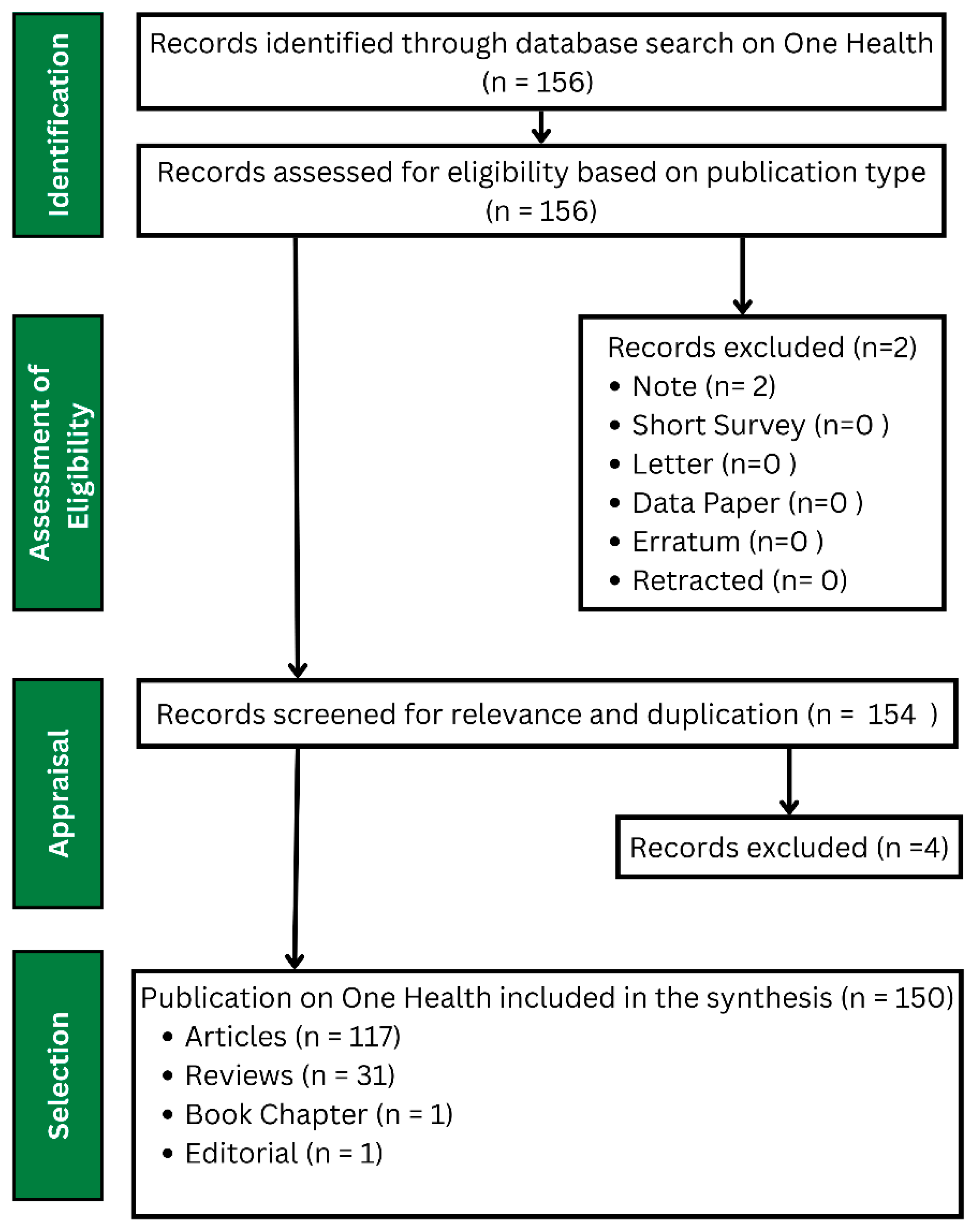
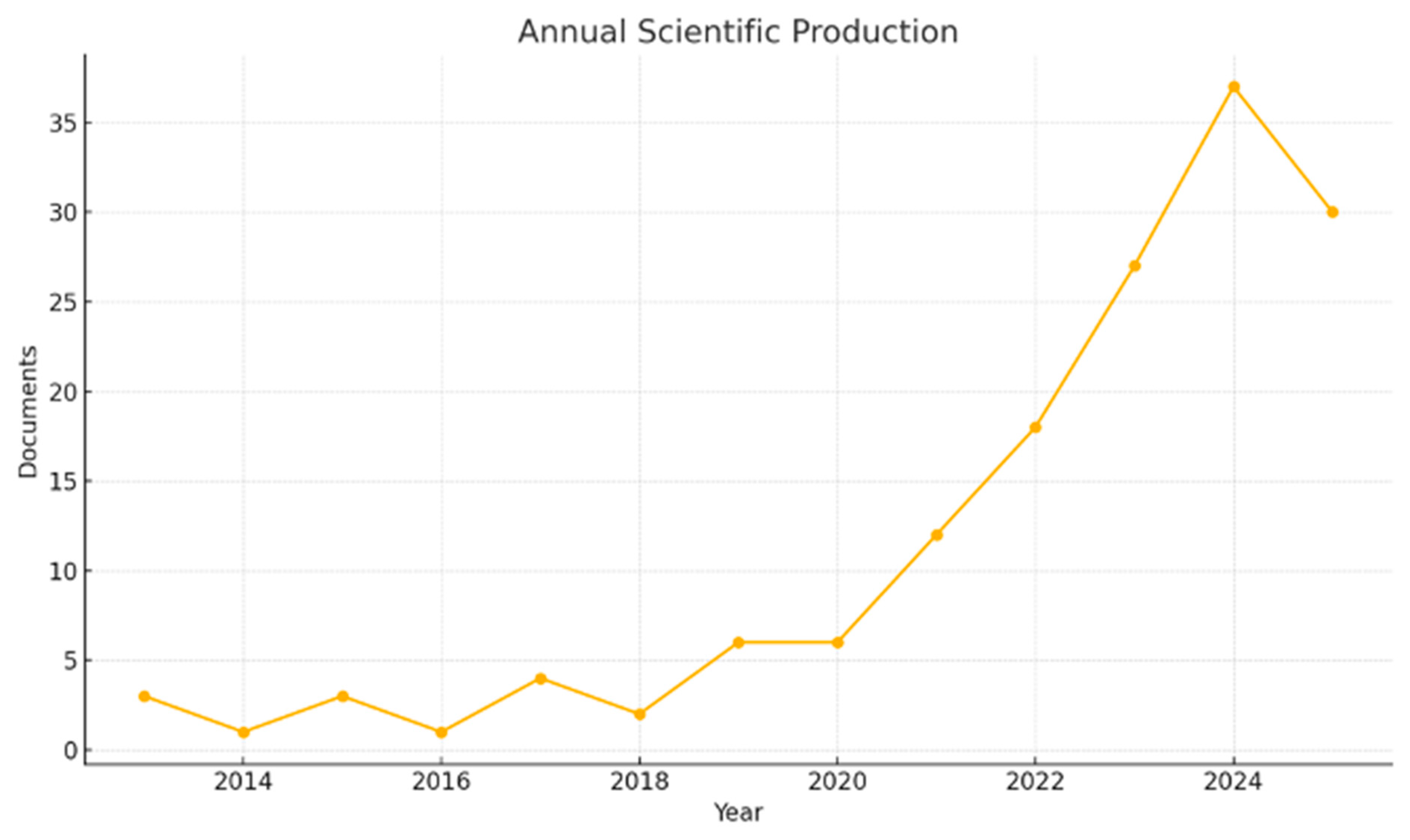
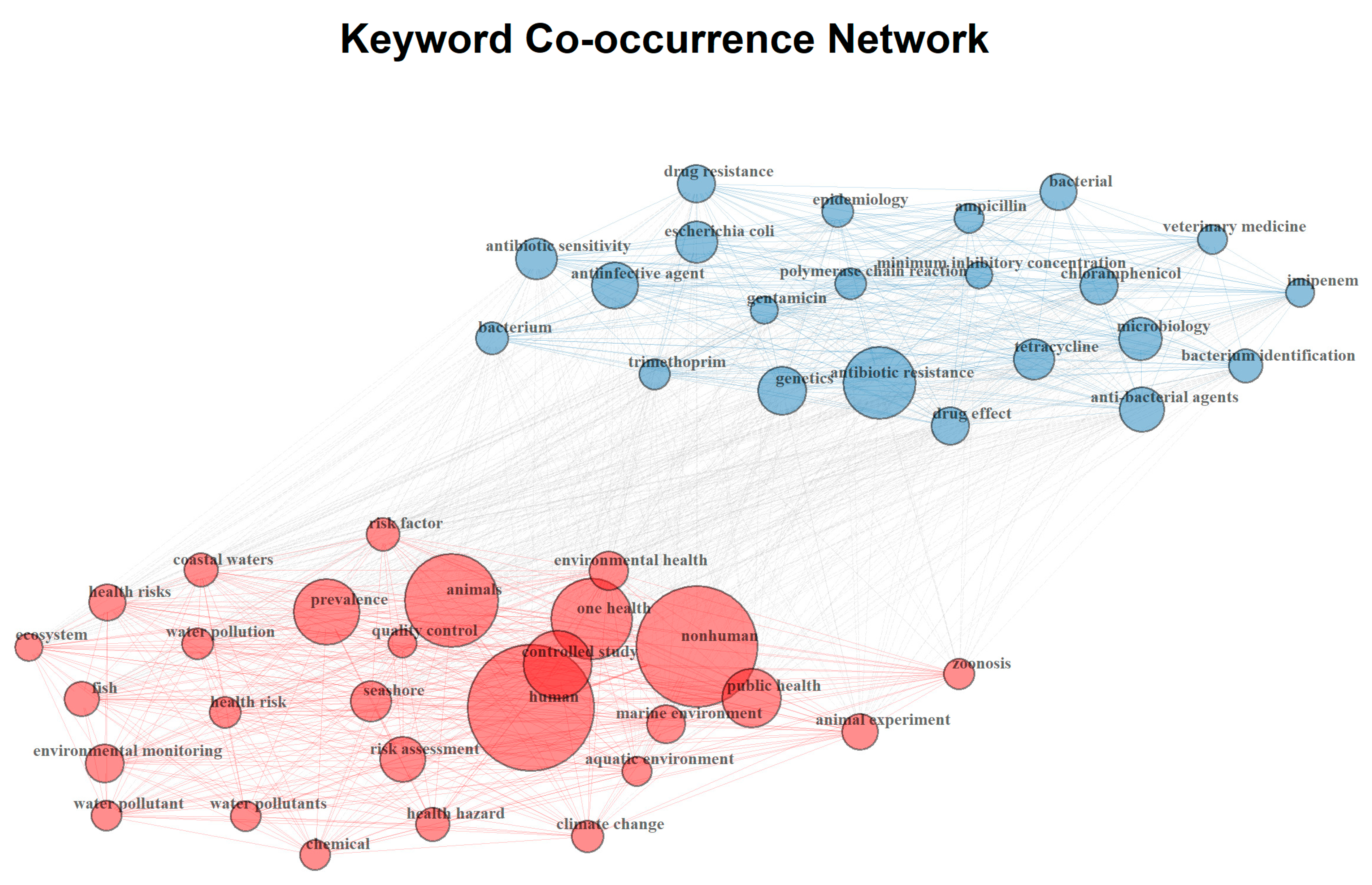
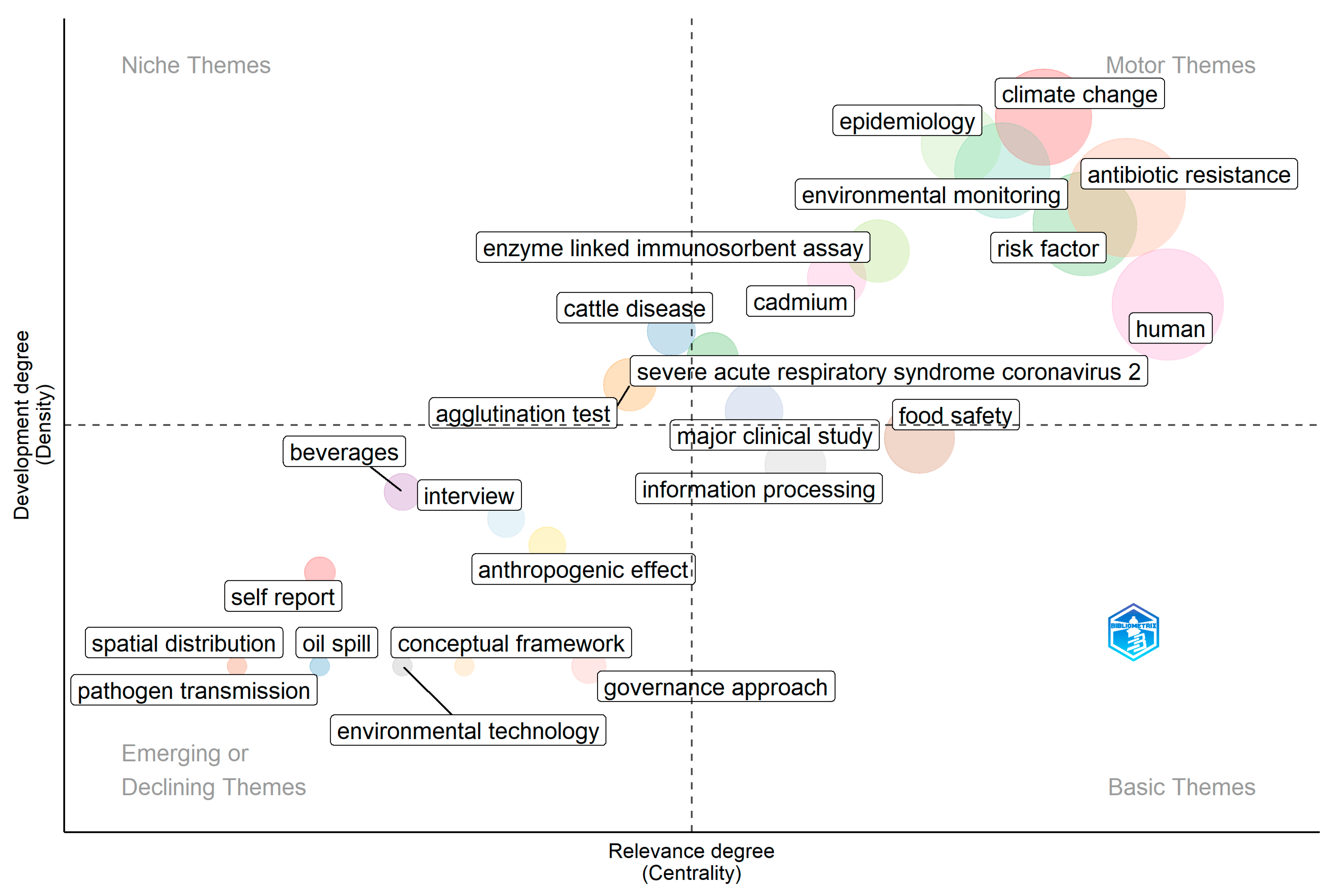
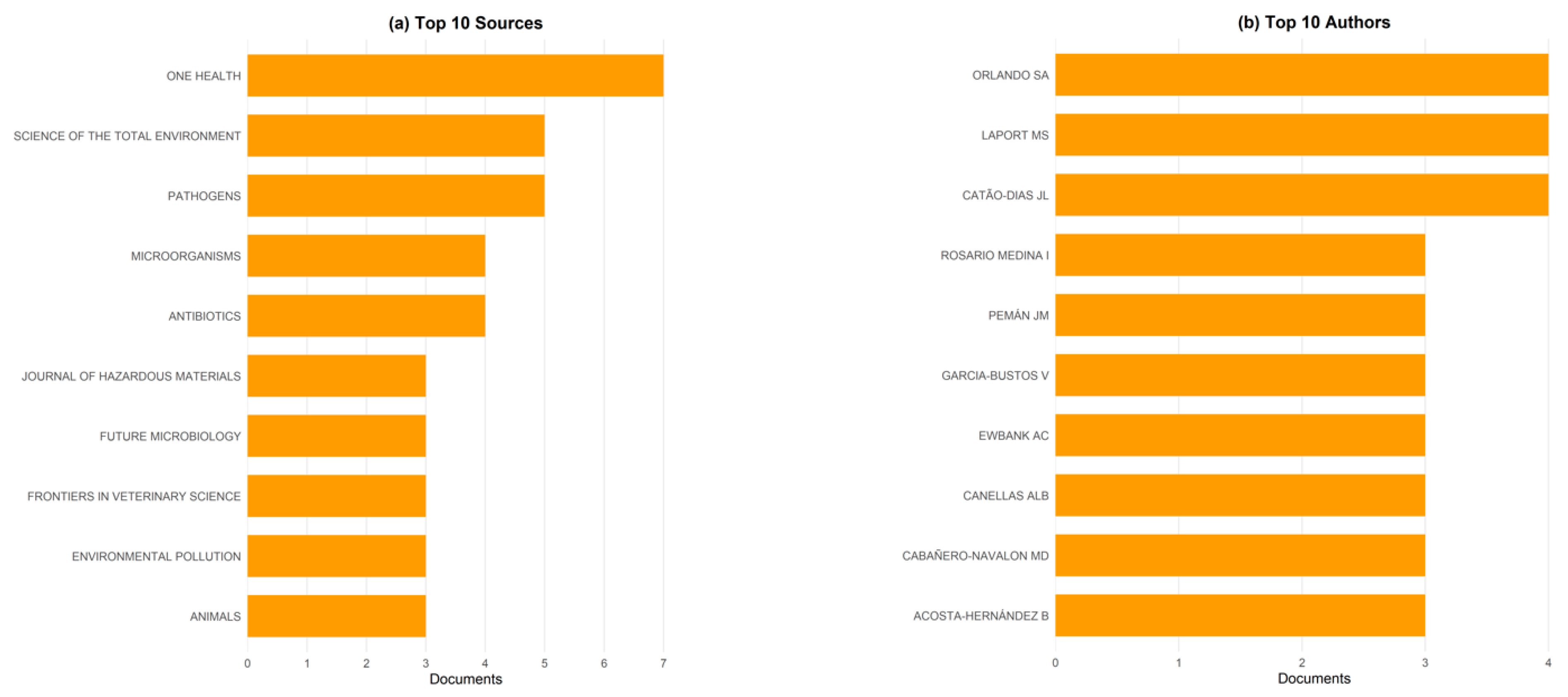

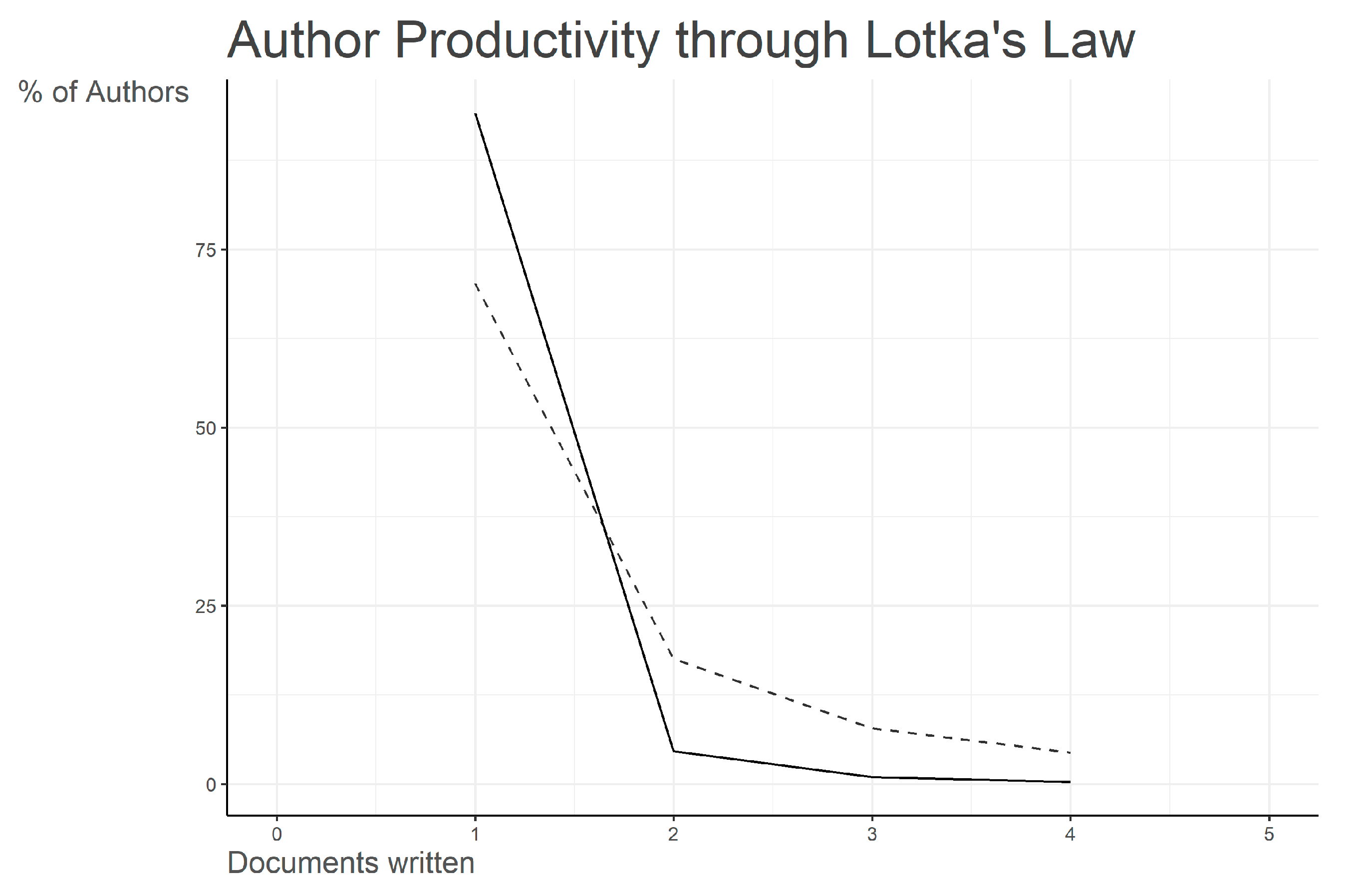
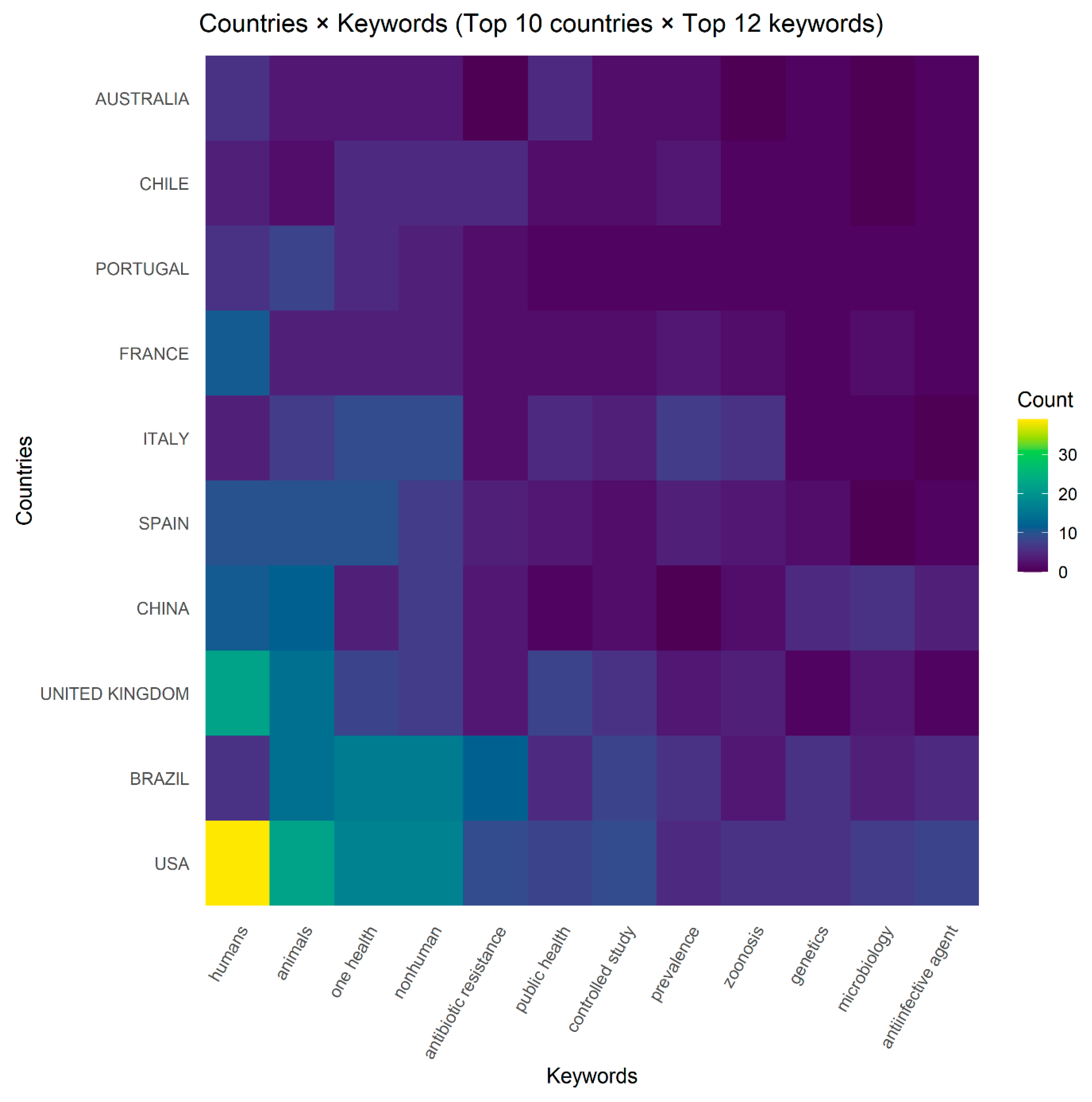
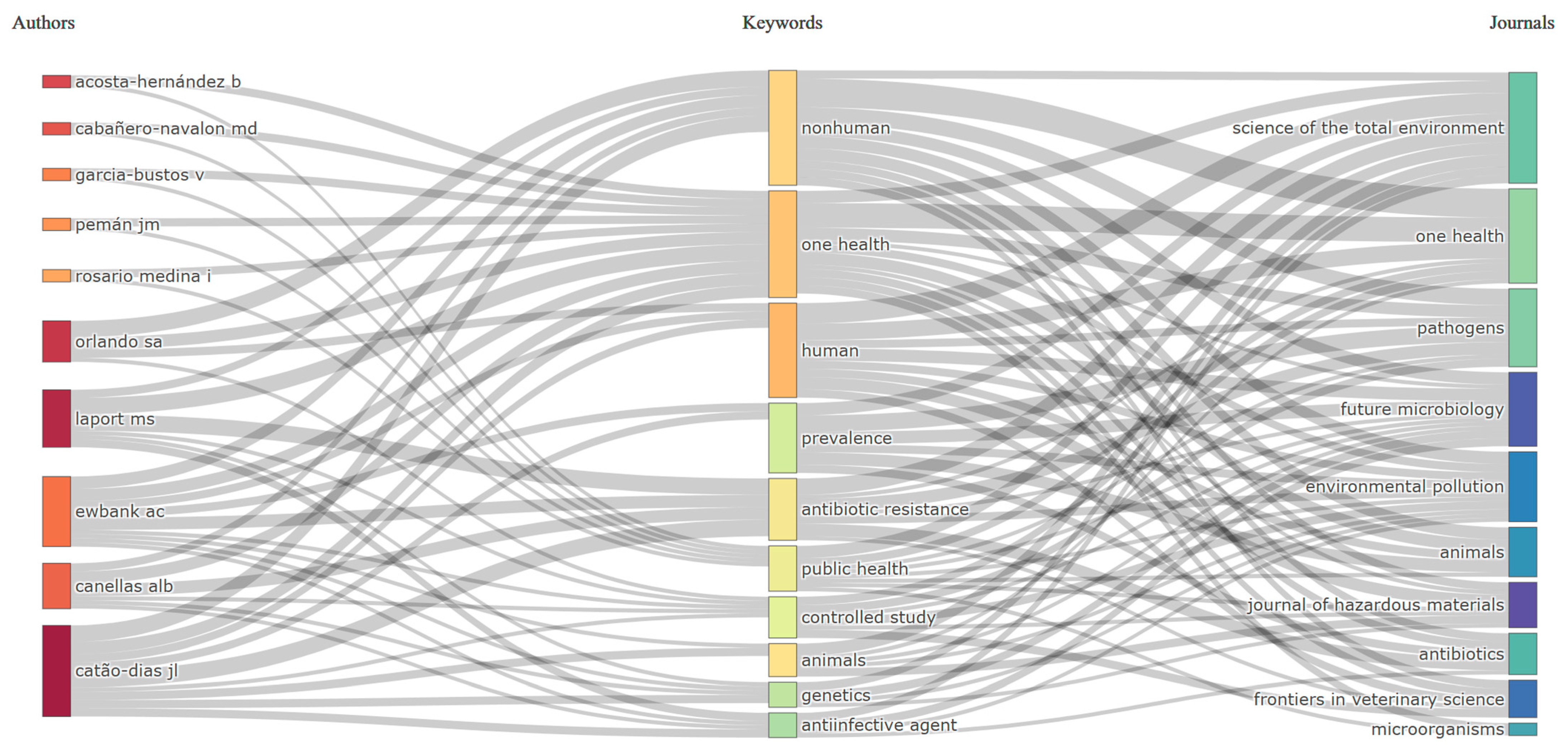
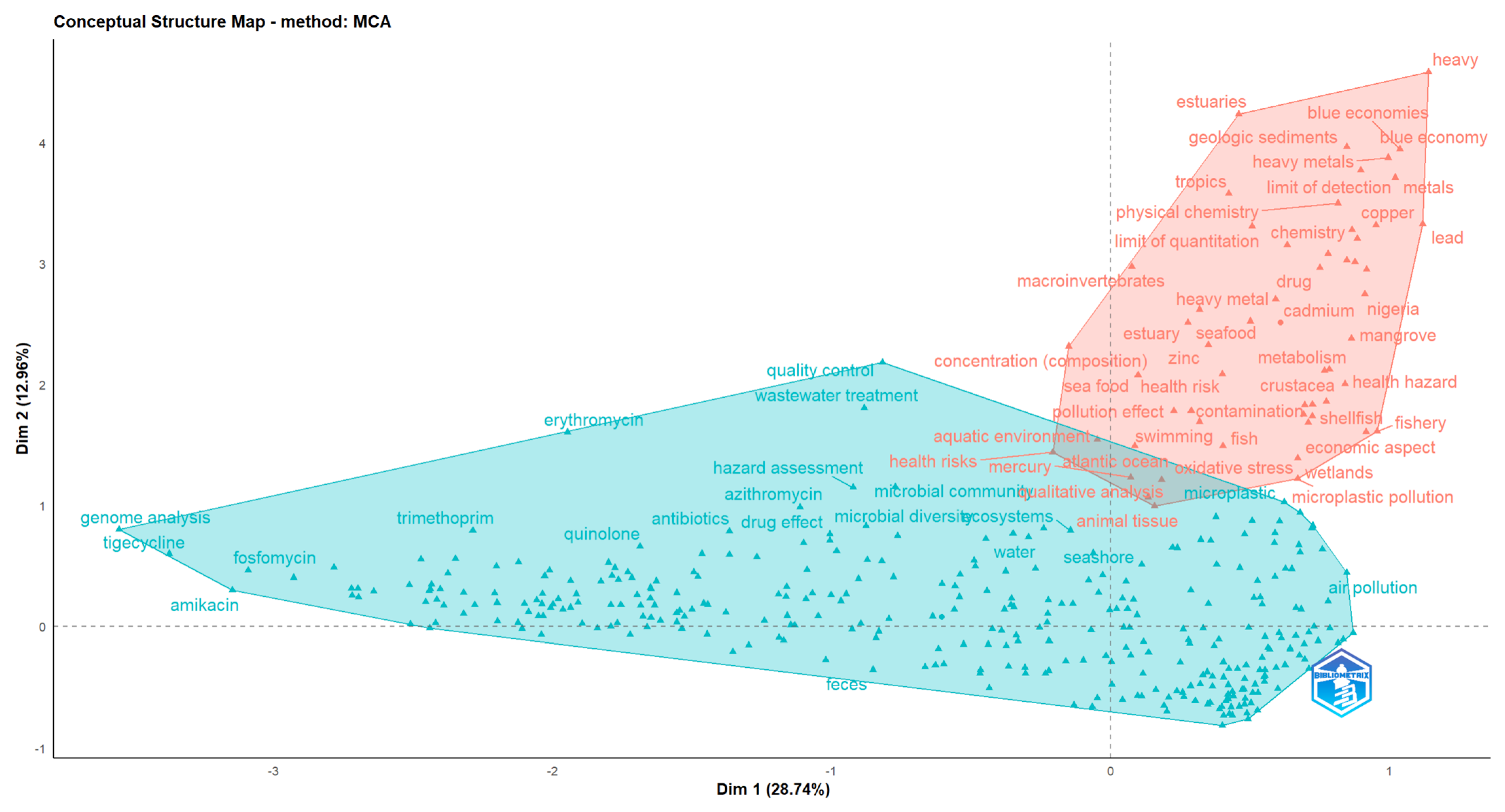

| Author (Year) | Journal | Theme Addressed | Total Citations |
|---|---|---|---|
| [5] | The Lancet | Planetary Health: conceptual framework linking human health and global change | 1947 |
| [51] | Emerging Infectious Diseases | Emerging infectious diseases and zoonotic spillover patterns | 228 |
| [52] | Nature Reviews Cardiology | Climate change impacts on cardiovascular disease | 190 |
| [53] | Journal of the World Aquaculture Society | Aquaculture sustainability and food systems | 98 |
| [54] | PLOS ONE | Antimicrobial use in livestock and AMR risks | 95 |
| [55] | One Health | Operational frameworks and approaches for One Health | 87 |
| [56] | Pathogens | Epidemiology of zoonotic diseases (COVID-19 focus) | 52 |
| [57] | Reviews on Environmental Health | Environmental degradation and its impacts on health | 49 |
| [58] | Marine Pollution Bulletin | Marine pollution and human/ecosystem health | 45 |
Disclaimer/Publisher’s Note: The statements, opinions and data contained in all publications are solely those of the individual author(s) and contributor(s) and not of MDPI and/or the editor(s). MDPI and/or the editor(s) disclaim responsibility for any injury to people or property resulting from any ideas, methods, instructions or products referred to in the content. |
© 2025 by the authors. Licensee MDPI, Basel, Switzerland. This article is an open access article distributed under the terms and conditions of the Creative Commons Attribution (CC BY) license (https://creativecommons.org/licenses/by/4.0/).
Share and Cite
Ioannou, A.; Bataka, E.; Kokosis, N.; Billinis, C.; Laspidou, C. One Health in Coastal and Marine Contexts: A Critical Bibliometric Analysis Across Environmental, Animal, and Human Health Dimensions. Int. J. Environ. Res. Public Health 2025, 22, 1523. https://doi.org/10.3390/ijerph22101523
Ioannou A, Bataka E, Kokosis N, Billinis C, Laspidou C. One Health in Coastal and Marine Contexts: A Critical Bibliometric Analysis Across Environmental, Animal, and Human Health Dimensions. International Journal of Environmental Research and Public Health. 2025; 22(10):1523. https://doi.org/10.3390/ijerph22101523
Chicago/Turabian StyleIoannou, Alexandra, Evmorfia Bataka, Nikolaos Kokosis, Charalambos Billinis, and Chrysi Laspidou. 2025. "One Health in Coastal and Marine Contexts: A Critical Bibliometric Analysis Across Environmental, Animal, and Human Health Dimensions" International Journal of Environmental Research and Public Health 22, no. 10: 1523. https://doi.org/10.3390/ijerph22101523
APA StyleIoannou, A., Bataka, E., Kokosis, N., Billinis, C., & Laspidou, C. (2025). One Health in Coastal and Marine Contexts: A Critical Bibliometric Analysis Across Environmental, Animal, and Human Health Dimensions. International Journal of Environmental Research and Public Health, 22(10), 1523. https://doi.org/10.3390/ijerph22101523












